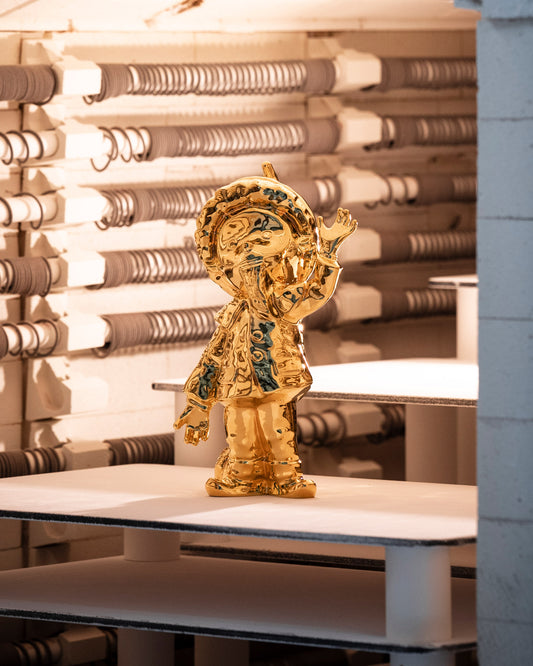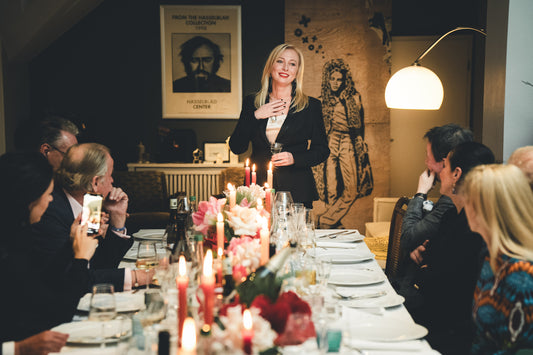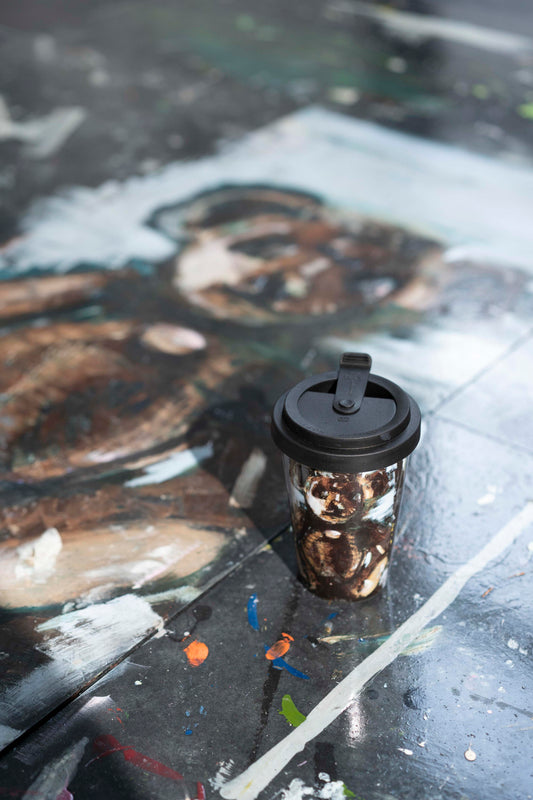LIGHT FROM THIS WORLD
In collaboration with KPM Berlin, Mark Braun designed PLANETARIUM, a lantern series of almost unearthly beauty. An interesting article from the KPM customer magazine WEISS No.4...
It is unusual, yes: heavenly light. Mark Braun takes the lantern made of the finest bisque porcelain in his hand and runs his finger over the velvety surface. There is a golden line all around with a dot on it. The hand-applied decoration symbolizes the orbit of the celestial bodies, with the light, the sun, at the center. Eight planets orbit it, especially Earth, that very point. The identifier “365 T” is handwritten on the bottom of the lantern – the number of days it takes the earth to circle the sun once.
Mark Braun designed the lantern, or more precisely: the PLANETARIUM lantern series, for KPM. It now includes not only our home planet, but also Jupiter and Mars, where the size of the points and the number of orbital days vary. Mercury, Venus, Saturn, Uranus and Neptune will follow.
“This circular movement is a metaphor that I really liked,” says the designer during a visit to his studio in Berlin-Alt-Treptow. “The focus is on the light, the brand, everything revolves around the manufacture and its production cycles.”
The casually dressed man in his mid-forties adjusts his cap. When you talk to the award-winning product designer about his designs, he always emphasizes the economic side. Perhaps this is the secret of his success. “I see it as my job to convey the potential of a company to the outside world with my products,” he explains. It is not enough to just be a good designer; entrepreneurial and intellectual knowledge also count. It's not enough to just have craftsmanship and talent, you also have to have good partners. Braun tries to think about the feasibility and production constraints of his clients. The collaboration with KPM is a “perfect match” – and the lantern series is a “perfect brand ambassador” for the manufacturer.
Because here the high quality and precision in the use of porcelain meet contemporary design. “The KPM stands for a lot of skill and history. “It is a company that has been very progressive in the past: for example in the Bauhaus era with designs by Trude Petri or Marguerite Friedlaender,” says Braun. “I wanted to dock on that.” With the PLANETARIUM lantern, form follows function; it spreads a pleasant, bright, windproof light in the dark. During the day, it is simply a beautiful design object.
Mark Braun knows his way around porcelain. During his studies as an industrial designer at the Burg Giebichenstein art college, he experimented intensively with the “bitchy material”. “Porcelain plus X” was the topic of his diploma thesis. In it he dealt with the contextualization of the material in relation to bathroom and table culture. Braun raves when he remembers: “In the workshops in Halle I had optimal conditions to try out new things.”
KPM Berlin is a company that has been very progressive in the past.
He also started his professional life with works made of porcelain: he designed a tableware for the manufacturer ASA Selection, his first major commercial success after completing his studies. Although he deliberately did not put his name on the service that was suitable for the masses, the contract gave him the necessary financial flexibility to subsequently promote his own products. In 2006 he set up his own design studio and moved into a studio house in Alt-Treptow where other artists and musicians had already moved in. An inspiring atmosphere for the young entrepreneur, who set up an office and workshop there. Today, new residential buildings have been built around the old building, which housed the Amiga music label's record workshop during GDR times, so that his office and workshop are hidden in the backyard. There he employs three people and as a team he develops different products from all imaginable materials.
Mark Braun is good at business and has a broad base. Today, his clients include well-known companies such as Hartô, Conmoto, Lobmeyr, mono, e15, Otto Hutt and Thonet , to name just a few. He designs vases, glass carafes, razor sets, trestles, cutlery, sofas, garden loungers, lights, jewelry and watches. He is particularly happy with the design of the “Metro” clock for NOMOS Glashütte, which has been a bestseller for years and is now available in 13 versions. No matter how different his products are, all designs bear his signature. They are well thought out, minimalist and pleasantly unobtrusive. Many of his works have been awarded renowned prizes such as the iF Design Award, the Red Dot Award and the German Design Award . But the success hasn't gone to the 45-year-old's head - he appears modest, calm and without any airs.
He owes his aesthetic influence to his family. The grandfather was an architect, the grandmother an artist. They owned a summer house in Sweden and attached great importance to its tasteful furnishings. The young Mark was surrounded by design classics, including many Scandinavian pieces, and learned early on to appreciate good products. Today, the father of two tries to pass on this feeling for design to his two children. “It is an important experience for children to come into contact with high-quality products,” says Braun. He gives his little daughter a nice drinking glass, even if something might break. He lives with his wife, the graphic designer Anna Sartorius, and their children in Kreuzberg. The Berliner by choice has arrived here. The city is always inspiring to him because Berlin is undergoing a lot of change. The KPM Berlin is also a piece of Berlin that he values. In the past, the manufactory has always had an “open door” for him – the best conditions for successful collaboration.
Text: Heike Glasses


